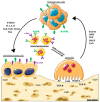Origin and Therapies of Osteosarcoma
- PMID: 35884563
- PMCID: PMC9322921
- DOI: 10.3390/cancers14143503
Origin and Therapies of Osteosarcoma
Abstract
Osteosarcoma (OS) is the most frequent primary bone tumor, mainly affecting children and young adults. Despite therapeutic advances, the 5-year survival rate is 70% but drastically decreases to 20-30% for poor responders to therapies or for patients with metastasis. No real evolution of the survival rates has been observed for four decades, explained by poor knowledge of the origin, difficulties related to diagnosis and the lack of targeted therapies for this pediatric tumor. This review will describe a non-exhaustive overview of osteosarcoma disease from a clinical and biological point of view, describing the origin, diagnosis and therapies.
Keywords: origin; osteosarcoma; therapy.
Conflict of interest statement
The authors declare no conflict of interest.
Figures

References
Publication types
LinkOut - more resources
Full Text Sources

